June 1, 2020 – CSXT 3118 leads Q647 as it splits the signals at the north end of the Kelly, Ky siding at it leads its train south on the Henderson Subdivision at dusk.
Tech Info: Full Frame Nikon D800, RAW, Irex 11mm, f/4, 1/500, ISO 1600.
June 1, 2020 – CSXT 3118 leads Q647 as it splits the signals at the north end of the Kelly, Ky siding at it leads its train south on the Henderson Subdivision at dusk.
Tech Info: Full Frame Nikon D800, RAW, Irex 11mm, f/4, 1/500, ISO 1600.
June 1, 2020 – Dusk settles across western Kentucky as CSX Q647 passes the signals at the south end of the siding at Kelly, KY as it rumbles south on the Henderson Subdivision at the old wooden overpass where preparations are underway its replacement with a new concrete bridge.
Tech Info: Nikon D800, RAW, Irex 11mm, f/4, 1/320, ISO 3200.
February 19, 2020 – An outbound and inbound Metra train pass each other at the Jefferson Park Metra Station during the evening rush hour to and from downtown Chicago, Illinois as the golden light of the day begins to fade from the sky.
February 20, 2020 – Metra 179 pulls train #919 southbound commuter train out of downtown Chicago, Illinois past the Amtrak facility as it approaches the 18th street overpass, as dusk falls over the city, on its way to Joliet, Illinois on the Metra Heritage Corridor.
February 20, 2020 – A Metra Express train passes another Metra local as they approach the Gladstone Park station on the UP-NW Line as they head northwest out of Chicago, Illinois at dusk.
February 4, 2020 – CSXT 3381 looks strange enough with one eye out, but throw in 7 double deck passenger cars running behind the power on CSX Q501-03 on the Henderson Subdivision at Slaughters, Kentucky, makes it even stranger! Here we see Q026 sitting on the main as Q501 with it’s 10,460 ft freight pulling south through the siding in a meet as 501 pulls south with 7 ex-Michigan (MI-train) passenger cars bound for Lebanon, Tennessee. I’m told they’ll be used on the Music City Star Commuter line.
November 4, 2019 – As the last light of the day begins to fade CSX Q513 passes the signals at Trenton, Kentucky as CSXT 3383 leads a manifest train south on the Henderson Subdivision.
March 26, 2019 – Cass Scenic Railroad Shays 4, 2, and 11, sit in the yard after a day of work at Cass, West Virginia, as lighting lights the sky from an approaching storm. Only person working this late night shift is the hostler, William H Taylor, who will keep the fires and water in the engines up to speed for another day of work. Thanks Bill for all the help in getting our night shots!!
May 28, 2019 – Well, after a three day whirlwind trip with fellow railfan Ryan Scott, of IndianaRails, to Tennessee, Virgina, West Virginia and Kentucky we both got back home last night. A big shout out to all the folks that helped us out along the way, especially Daniel Alls, Walter Scriptunas II, Jul Esp, Bryan Burton, Gavin Wilkes and all the others that responded to our posts for questions and help in the different areas we visited! Without your help and input the trip would have been a lot less successful! Got a lot of pictures to work through and many posts yet to come from this 4 day trip!
According to Wikipedia: Shay #11 was built in 1923 and went originally to Hutchinson Lumber Company, Feather Falls, California. This Shay is best known as the Feather River #3 and it’s also a class C shay, #11, weighs 103-tons. It began service at Cass in 1999.
This morning’s image was shot the night of May 26th after a spring storm made its way through the Cass Scenic Railroad area and is of Shay #11 at rest in the yard after a days work at Cass, West Virginia. Shooting at night and in the rain can be challenging, but probably the hardest part is getting out the door!
My kit bag for this type of shooting is a golf umbrella and a large microfiber cloth to dry off the camera and lens with when drops make it past the umbrella! Of course a good sturdy tripod is a must as well. I typically set the camera on manual and adjust for the specific scene, with the camera controls set to a 3 second delay before the shutter is tripped. This raises the mirror and lets things settle before taking the photo. ISO and length of exposure all depend on the lighting, but they’re set manually as well. This particular shots technical details are: Nikon D800, Sigma 24-70 lens @ 26mm, ISO 1000 (full frame cameras are great) f/8 for 30 seconds in RAW.
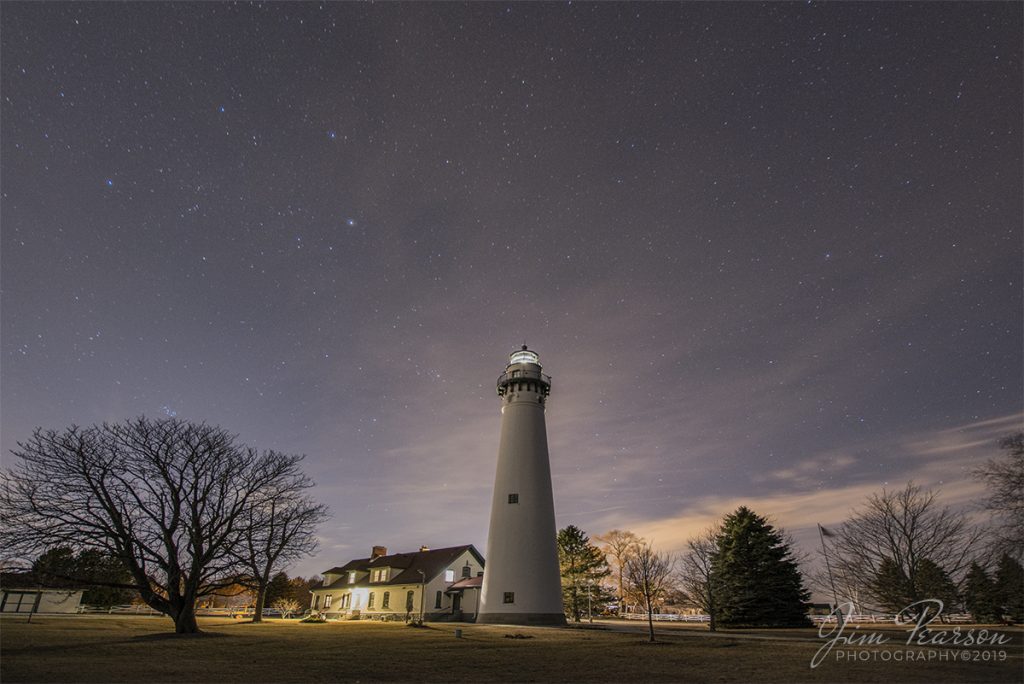
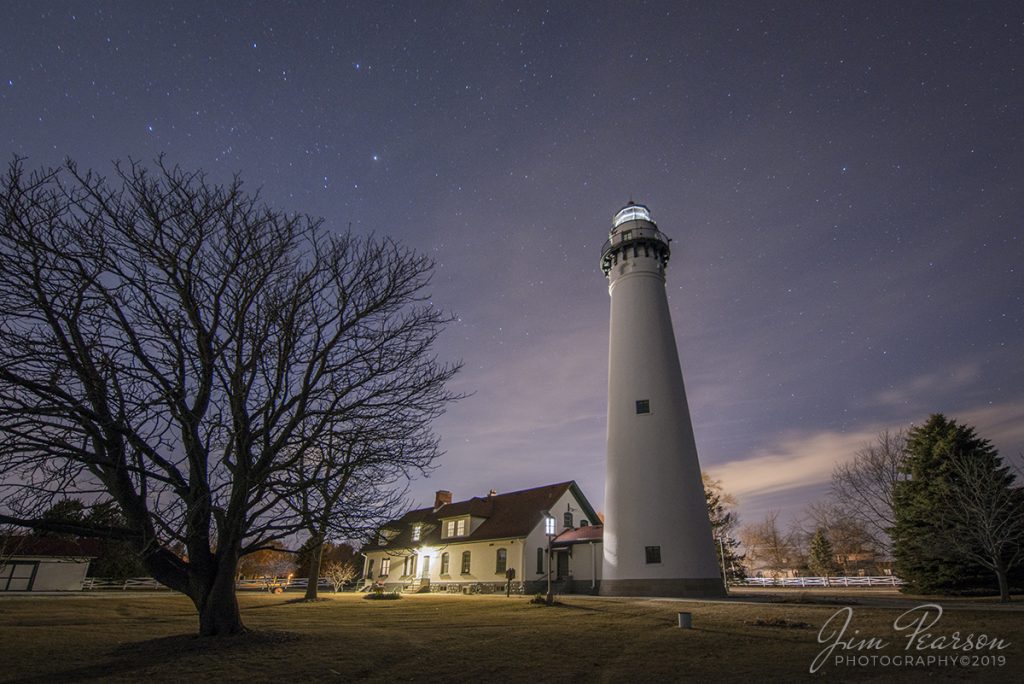

March 24, 2019 – Well, my attempt at photographing the northern lights was a bust on my Chicago trip last weekend, but it did result in a few nice photographs of the Wind Point Lighthouse which I post here for your enjoyment!
According to Wikipedia, Wind Point Lighthouse is a lighthouse located at the north end of Racine Harbor in the U.S. state of Wisconsin. It is in the village of Wind Point, Wisconsin, on Lighthouse Road. The lighthouse stands 108 feet tall.
The Wind Point Lighthouse is one of the oldest and tallest still operating on Lake Michigan.
The Lighthouse was built in 1880 and was designed by Orlando Metcalfe Poe who had served in the Civil War as a Brigadier General. After the war, he served as engineer secretary of the Lighthouse Board and was in charge of lighthouse construction. It was lit for the first time on November 15, 1880.
January 21, 2019 – A Paducah and Louisville railway local passes through PAL’s West Yard, with 3808 leading on its way south, as the last light of day begins to fade from the sky. Parked at the right is PAL 3801 (GP38), University of Louisville Cardinals engine. – #jimstrainphotos #kentuckyrailroads #trains #nikond800 #railroad #railroads #train #railways #railway #pal #palrailway
November 21, 2018 – Arriving just over 3 hours late due to mechanical problems in Chicago, Amtrak 391, the Saluki, meets a northbound CN freight at the coaling towers in Carbondale, Illinois as the last light of the day fades from the sky on the Centrailia Subdivision. #jimstrainphotos #illinoisrailroads #trains #nikond800 #railroad #railroads #train #railways #railway #amtrak #passengertrains #cn#cnrailway
November 3, 2018 – Indiana Railroad 9004 leads Z464 as it pulls onto the CSX CE&D Subdivision’s Baker siding at Terre Haute, Indiana to perform interchange work with CSX as the last light of the day fades from the sky.
According to Wikipedia: The Indiana Rail Road (reporting mark INRD) is a United States Class II railroad, originally operating over former Illinois Central Railroad trackage from Newton, Illinois, to Indianapolis, Indiana, a distance of 155 miles. This line, now known as the Indiana Rail Road’s Indianapolis Subdivision, comprises most of the former IC line from Indianapolis to Effingham, Illinois; Illinois Central successor Canadian National Railway retains the portion from Newton to Effingham. INRD also owns a former Milwaukee Road line from Terre Haute, Indiana, to Burns City, Indiana (site of the Crane Naval Surface Warfare Center), with trackage rights extending to Chicago, Illinois. INRD serves Louisville, Kentucky, and the Port of Indiana on the Ohio River at Jeffersonville, Indiana, through a haulage agreement with the Louisville & Indiana Railroad (LIRC). – #jimstrainphotos #indianarailroads #trains #nikond800 #railroad #railroads #train #railways #railway #csx #csxrailroad #inrdrailroad #indianarailroad
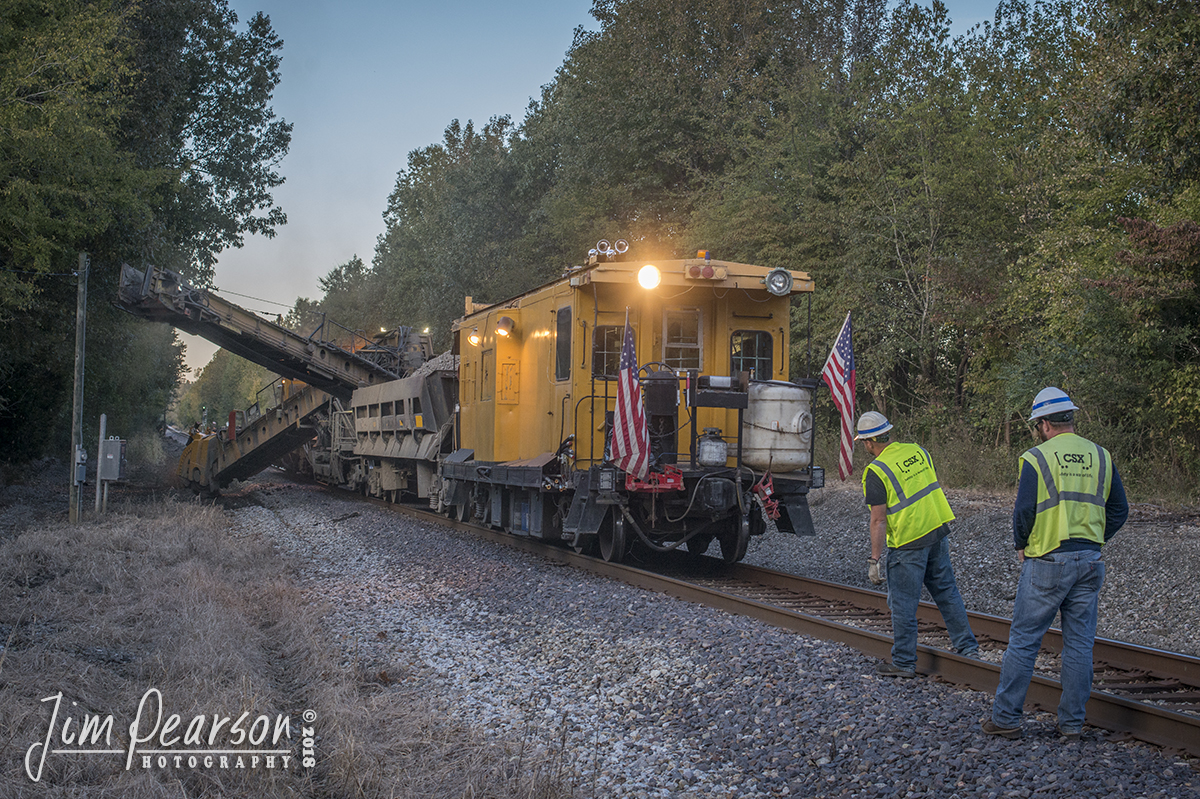
October 22, 2018 – CSX crews keep an eye on LoRam Ditch Cleaner (DC-2) as it works its way north on the Earlington Cutoff of the Henderson Subdivision at the Flat Creek Road Crossing in Mortons Gap, Ky.
According to LoRam’s Website: Ditch Cleaning Is essential for the longevity and foundational strength of a railway, proper ditch maintenance increases the stability of ballast and subgrade by moving water away from the track and right of way. Delivering substantial benefits and ROI, ditch cleaning increases cycle time between expensive surfacing and lining programs, prevents premature tie deterioration and ensures a long-lasting and stable track structure.
Lorams drainage maintenance solutions, including shoulder ballast cleaning, undercutting and ditch cleaning, work in concert to ensure that damaging water is intercepted and diverted from the track infrastructure.
Cleaned, maintained and properly-sloped ditches provide a host of benefits including: Facilitates vital drainage from the ballast section of the track, Manages the effects of penetrating water sources, Ensures the efficacy of track level drainage maintenance and Reduces or eliminates water-saturated track soils. – #jimstrainphotos #kentuckyrailroads #trains #nikond800 #railroad #railroads #train #railways #railway #csx #csxrailroad
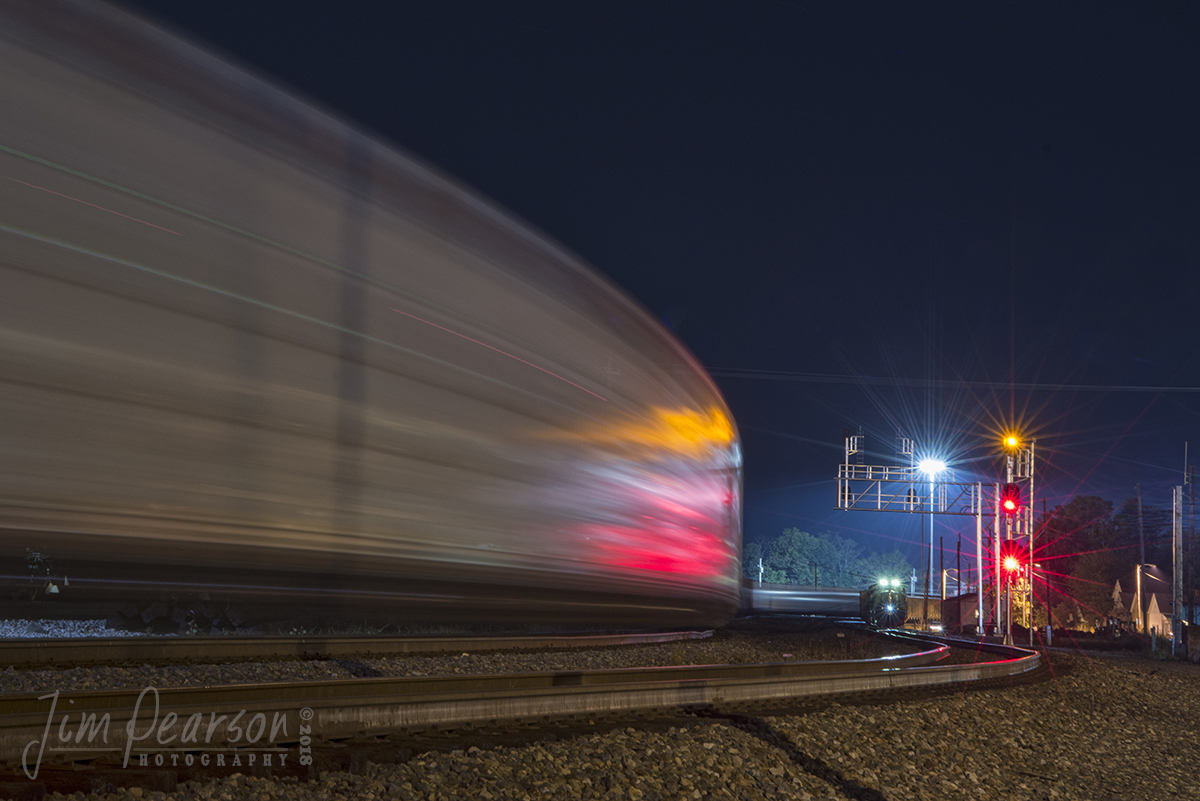
October 6, 2018 – Signals reflect off the side of CSX Q647, as makes its way through Howell Yards, in Evansville, Indiana, as it continues south to it’s final destination of Waycross, GA. – #jimstrainphotos #kentuckyrailroads #trains #nikond800 #railroad #railroads #train #railways #railway #csx #csxrailroad
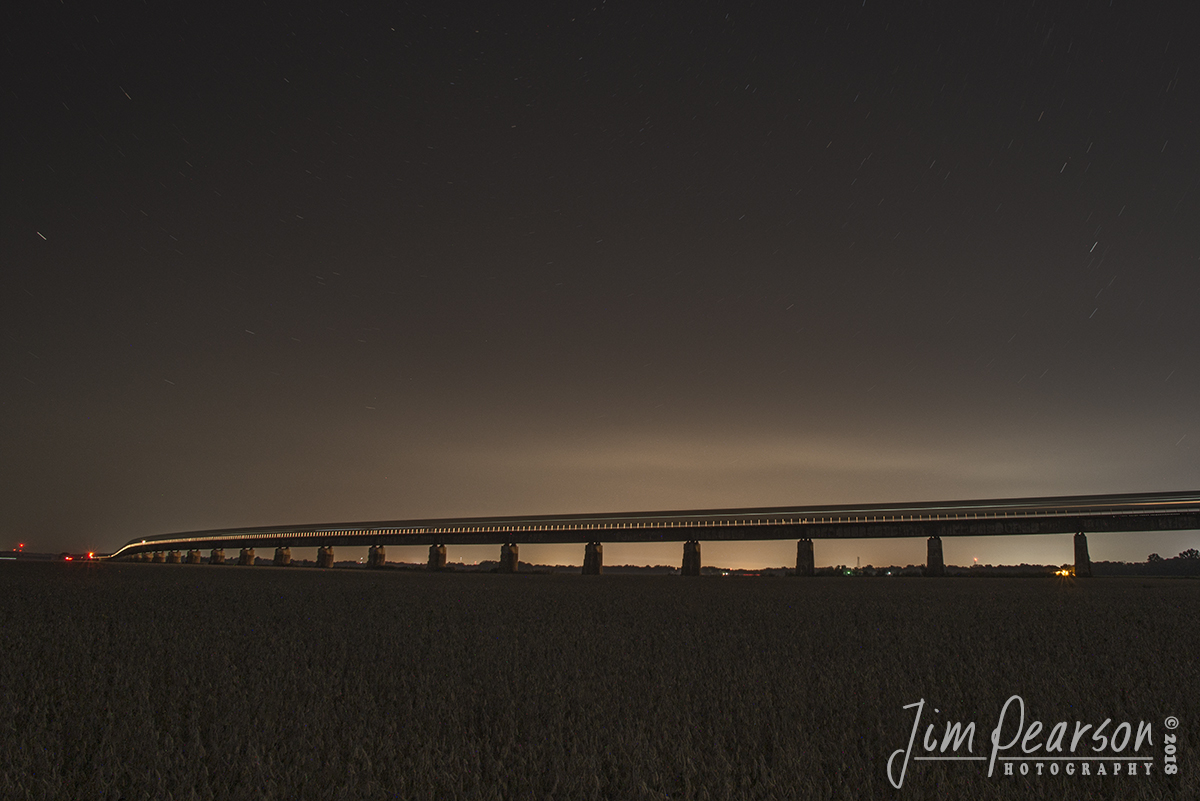
October 6, 2018 – Against the night sky glow from Evansville, Indiana the headlights from CSX E306 lights up the railing as it heads slowly down the viaduct at Rham, Indiana with its empty coal train after crossing over the Ohio River on the Henderson Subdivision. Nikon D800, 4 min exposure at f/11 at ISO 100 with a Nikon 18mm lens. – #jimstrainphotos #indianarailroads #trains #nikond800 #railroad #railroads #train #railways #railway #csx #csxrailroad
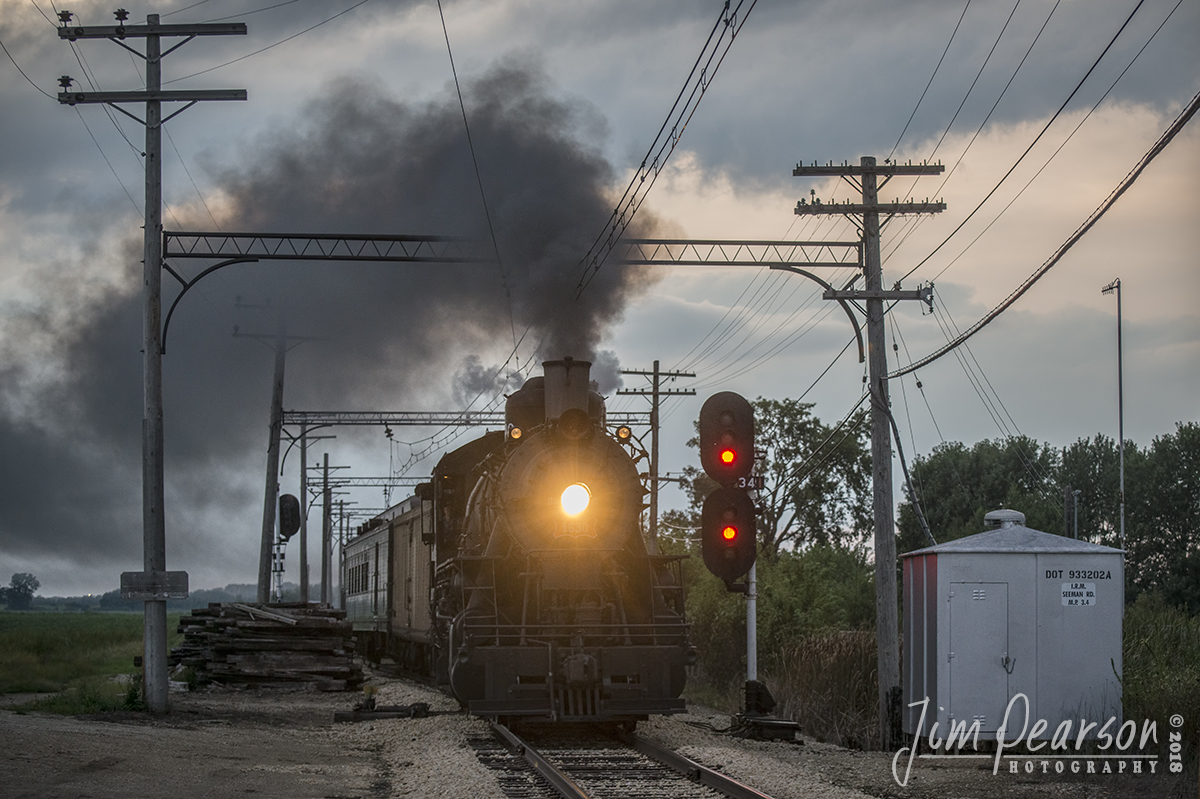
September 1, 2018 – St. Louis-San Francisco Railroad steam locomotive 1630 approaches the Seeman Road Crossing, outside the Illinois Railway Museum in Union, Illinois as the last light of day begins to fade from the sky. – #jimstrainphotos #illinoisrailroads #steamtrains #nikond800 #railroad #railroads #train #railways #railway #illinoisrailwaymuseum #steamtrain
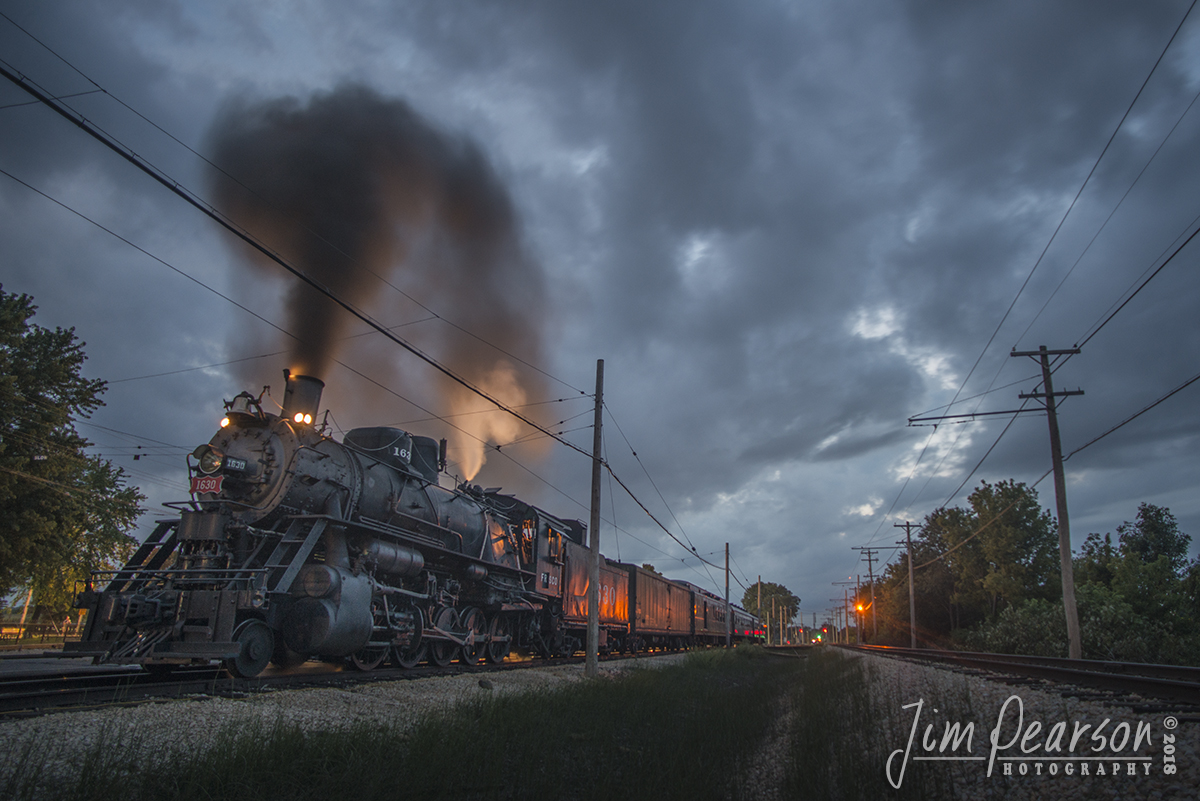
September 1, 2018 – St. Louis-San Francisco Railroad steam locomotive 1630 sits in the station at the Illinois Railway Museum in Union, Illinois, waiting for it’s 8pm run, as the last light of day begins to fade from the sky.
According to Wikipedia, the locomotive was built in 1918 by the Baldwin Locomotive Works for use in Russia as a class Ye locomotive. However, it, along with approximately 200 other locomotives, remained in the United States, due to the inability of the Bolshevik government to pay for them, following the Russian Revolution.
1630 was converted from 5 ft (1,524 mm) Russian track gauge to 4 ft 8 1/2 in (1,435 mm) standard gauge. After being re-gauged, #1630 was sold to the USRA and was numbered 1147. Shortly after, 1147 was briefly leased for use on the Pennsylvania Railroad.
In 1920, the locomotive was sold to the St. Louis – San Francisco Railway, where it was used as a mixed traffic engine. In 1951, the locomotive was sold to Eagle-Picher, who used it to haul lead ore from a mine to their smelter.
In 1967, the locomotive was donated to the Illinois Railway Museum, in Union, Illinois, where they began restoring it in 1972, it returned to operating condition in 1974 and made its first revenue run. Sometime after arriving at the museum, 1630 was restored from her Eagle Picher appearance back to her Frisco appearance. 1630 was taken out of service in 2004, and after more than six years undergoing repairs and a federally mandated rebuild, it was returned to operational condition on October 30, 2013.
On Memorial Day weekend 2014, the locomotive returned to excursion service. In 2016, the locomotive received a cylinder overhaul, which according to Steam department curator, Nigel Bennett, made the locomotive, “probably more powerful than she has been since her [sic] first arrival at IRM in the 1970s.” The locomotive, during Memorial Day weekend 2016, pulled 137 empty coal cars in storage at the museum as what was considered to be one of the longest revenue freight trains powered by a steam locomotive in at least 25 years as said by IRM’s Steam department curator. – #jimstrainphotos #illinoisrailroads #steamtrains #nikond800 #railroad #railroads #train #railways #railway #illinoisrailwaymuseum #steamtrain
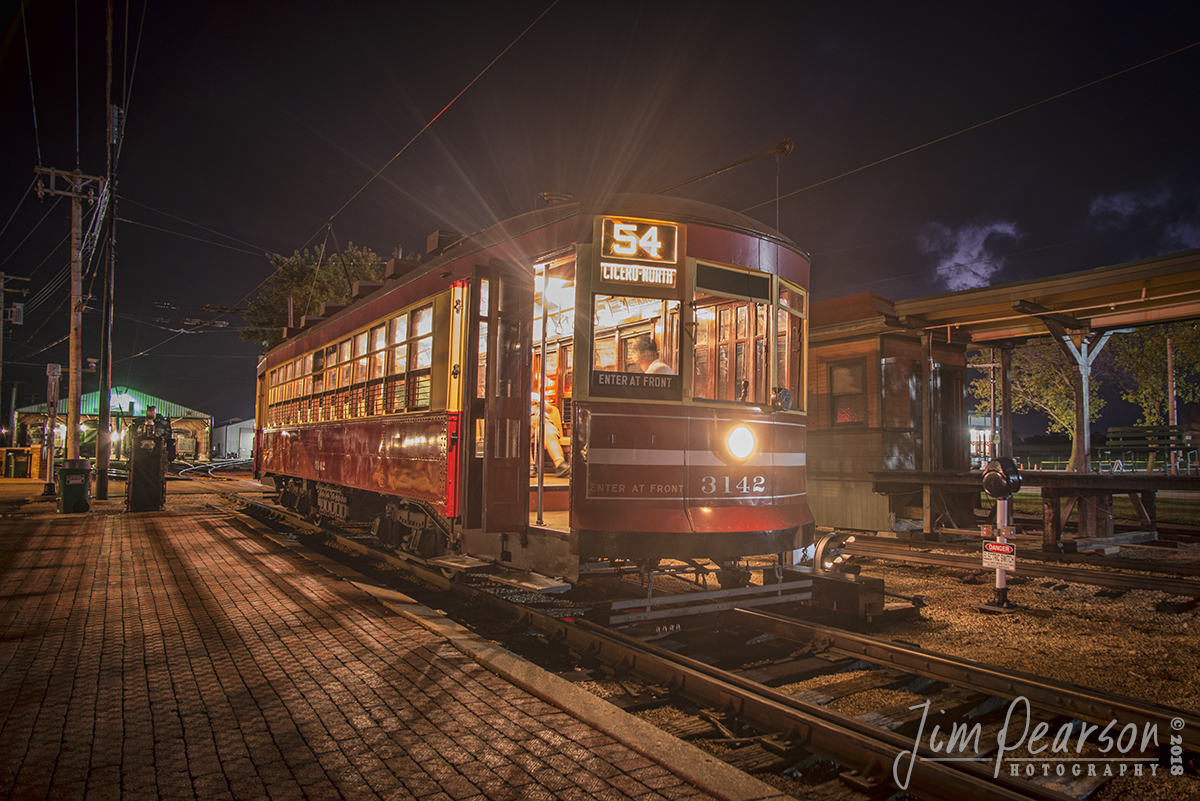
September 1, 2018 – Chicago Surface Lines street car 3142 arrives at the the Illinois Railway Museum street car platform at in Union, Illinois during the museums recent late night session on Saturday. They were scheduled to operate also on September 2 and 3rd, but due to flooding the event was canceled. This shot was about 30 minutes before the rains arrived.
It was donated to the IRM in 1973 by the Electric Railway Historical Society and after 15 years of restoration by IRM volunteers the car returned to operation in 2001. It is the only surviving CSL arch roof streetcar and has 48 seats. It was built in 1923 by the J. G. Brill Company.
According to Wikipedia, The first streetcars in Chicago were horse cars run by the Chicago City Railway Company and the North Chicago City Railway Company around 1858-1861. This method was slow and expensive, and the companies began substituting cable cars in the 1880s. Chicago City Railway was the first in (1881), and with the addition of the Chicago Passenger Railway (1883) and the West Chicago Street Railroad Company (1887), Chicago had the largest cable railway system in the world. The north and west side cable car systems were constructed by an investment syndicate under the direction of Charles Yerkes.
It was also in the 1880s that electric-powered “trolleys” first became practical. The Chicago companies hesitated at first to install these faster and more efficient systems because of their heavy investment in cable cars. But the smaller Illinois cities and the Calumet Electric Street Railway of the South Side built successful systems, causing the Chicago companies to feel themselves dropping behind. By the mid-1890s most of them had begun the conversion to electricity, which was completed in 1906.
The 1890s saw the consolidation of many of the Chicago companies, and this reorganization continued into the next century. In 1907 to 1909, the companies were granted franchises pursuant to various ordinances, under which the city reserved the right to purchase the systems. The Settlement Ordinance of 1907 imposed various operating requirements on two of the underlying companies, the Chicago City Railway Company and Chicago Railways, and established a new bureau, the Board of Supervising Engineers (Chicago Traction), a board of engineers and accountants with responsibilities for assuring compliance with the ordinances, and setting standards for equipment and construction.]
Through Routes over the lines of several companies were instituted in 1910, and, for instance, resulted in joint service by the Chicago City Railway Company and Calumet and South Chicago Railway between downtown and 119th Street via Cottage Grove. There was also joint service operated by the South Chicago City Railway and the Hammond, Whiting, and East Chicago Electric Railway into Indiana, with each company collecting its own fare, which continued until the Hammond company converted to buses in 1940.
The continuous reorganization was finally completed by the Unification Ordinance of 1913, which stipulated that all lines would come under the management of a single operating association called the Chicago Surface Lines (CSL), and unified operations commenced in 1914. Four companies formed the CSL: the Chicago Railways Company, Chicago City Railway, Calumet and South Chicago Railway, and Southern Street Railway. At this time, Chicago had the largest street railway system, the longest one-fare ride, the longest average ride, and the most liberal transfer privileges in the world.
The 1920s saw continued growth despite the increasing competition from the automobile, and while the 1933-1934 World’s Fair and wartime demand supported ridership, the underlying companies were bankrupt. Creditors’ bills were filed against the Chicago Railways in 1926 and the Chicago City Railway and Calumet and South Chicago in 1930, resulting in the appointment of receivers and bringing their property into the custody of the Federal District Court. In 1944, the proceedings were converted to those under the Bankruptcy Act, and trustees were appointed. By 10 June 1958 (line 22), the Chicago Transit Authority, which took over the Chicago Surface Lines in 1947, had abandoned the remaining streetcars lines, which were “bustituted.” Before that, CSL had introduced gasoline buses for light routes in 1927, and trolley buses to the northwest side starting 17 April 1930. Trolleybus system of Chicago scrapped 25 March 1973.
The Chicago Surface Lines was primarily a trolley operation, with approximately 3100 streetcars on the roster at the time of the CTA takeover. It purchased small lots of motor buses, totaling 693 at the time of the CTA (Chicago Transit Authority) takeover, mostly consisting of smaller buses used on extension routes or to replace two-man streetcars on routes such as Hegewisch and 111th Street, because conductors were required to flag streetcars across mainline railroads where there was not a watchman at the crossing. Most postwar PCC cars were scrapped and parts reused in the 6000-series rapid transit cars for the CTA. The trolley bus fleet consisted of 152 vehicles. – #jimstrainphotos #illinoisrailroads #trains #nikond800 #railroad #railroads #train #railways #railway #cta #thechicagol #chicago
September 1, 2018 – St. Louis-San Francisco Railroad steam locomotive 1630 passes through the crossing approaching the station at the Illinois Railway Museum in Union, Illinois as the last light of day begins to fade from the sky.
According to Wikipedia, the locomotive was built in 1918 by the Baldwin Locomotive Works for use in Russia as a class Ye locomotive. However, it, along with approximately 200 other locomotives, remained in the United States, due to the inability of the Bolshevik government to pay for them, following the Russian Revolution.
1630 was converted from 5 ft (1,524 mm) Russian track gauge to 4 ft 8 1/2 in (1,435 mm) standard gauge. After being re-gauged, #1630 was sold to the USRA and was numbered 1147. Shortly after, 1147 was briefly leased for use on the Pennsylvania Railroad.
In 1920, the locomotive was sold to the St. Louis San Francisco Railway, where it was used as a mixed traffic engine. In 1951, the locomotive was sold to Eagle-Picher, who used it to haul lead ore from a mine to their smelter.
In 1967, the locomotive was donated to the Illinois Railway Museum, in Union, Illinois, where they began restoring it in 1972, it returned to operating condition in 1974 and made its first revenue run. Sometime after arriving at the museum, 1630 was restored from her Eagle Picher appearance back to her Frisco appearance. 1630 was taken out of service in 2004, and after more than six years undergoing repairs and a federally mandated rebuild, it was returned to operational condition on October 30, 2013.
On Memorial Day weekend 2014, the locomotive returned to excursion service. In 2016, the locomotive received a cylinder overhaul, which according to Steam department curator, Nigel Bennett, made the locomotive, “probably more powerful than she has been since her [sic] first arrival at IRM in the 1970s.” The locomotive, during Memorial Day weekend 2016, pulled 137 empty coal cars in storage at the museum as what was considered to be one of the longest revenue freight trains powered by a steam locomotive in at least 25 years as said by IRM’s Steam department curator. – #jimstrainphotos #illinoisrailroads #steamtrains #nikond800 #railroad #railroads #train #railways #railway #illinoisrailwaymuseum #steamtrain